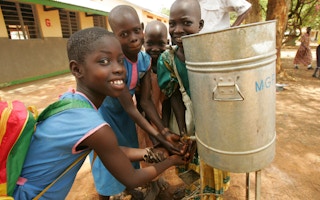The benefits of providing water, sanitation and hygiene (WASH) are fundamental and far-reaching: we see how families can better lift themselves out of poverty following the installation of a borehole, how women are freed from the daily burden of water collection, and how the provision of safe, private toilets in schools allow more girls to attend classes during their periods.
We also see the economic benefits as sick days decrease, educational attainment rises and women are empowered to join the workforce. It is why World Bank economists say every £1 spent on taps and toilets reaps at least £4 in economic benefits.
Next month marks the second anniversary of the Sustainable Development Goals (SDGs), a set of 17 targets agreed by world leaders with the aim of ending poverty and hunger and bringing health, education, social equality and more to everyone, everywhere by 2030.
But the provision of clean water, decent toilets and good hygiene must be at the heart of each and every one of these goals if they’re to be achieved.
After all, how can we achieve health targets when 38% of clinics in the developing world don’t have water for drinking, handwashing and cleaning? How can food provision alone end hunger when half of all malnutrition cases are linked to chronic diarrhoea caused by a lack of clean water, good sanitation and good hygiene?
How can we achieve gender equality when women and girls still shoulder responsibility for sourcing water for their families, at the expense of their education and employment?
Unless the provision of water, sanitation and hygiene is given a central role in such efforts the risk is that well-intentioned aid funding cannot be fully successful in its efforts.
Last month I visited a district health centre in south-central Mali which bought this problem to the forefront of my mind. Until last year this maternity and surgical hospital only had water for three hours a day, making handwashing and cleanliness impossible.
Now thanks to WaterAid and its partners, this health centre in the town of Bla, and more than 20 other smaller medical centres across the region of Segou and Mopti boast a constant clean water supply, running water in every room and accessible toilets.
Doctors smiled proudly as they told me the neonatal infection record book’s pages were largely empty now that doctors, nurses and midwives can follow rigorous hygiene practices, including washing their hands with soap.
“
But the provision of clean water, decent toilets and good hygiene must be at the heart of each and every one of these goals if they’re to be achieved.
But despite progress, there is still some way to go in Mali. An estimated 4,000 children under the age of five die here every year from diarrhoeal diseases caused by poor water and sanitation. 12 million Malians do not have a decent toilet and more than a quarter of the population does not have clean water.
This trend is repeated across the developing world. Globally 844 million people live without clean water within reach, and 2.3 billion are without a decent, private toilet.
Hygiene, sanitation and water are a fundamental and crucial step towards achieving all the other Global Goals. The SDGs’ commitment to ‘leave no one behind’ cannot be achieved while the world’s most marginalised lack access to these fundamental human rights. We must bring these numbers to zero if we have any hope of wiping out extreme poverty.
My visit to Mali offered a glimmer of hope. The Malian government has asked other development agencies like UNICEF and WHO to incorporate WaterAid’s ‘basic water and sanitation package’ into their own programmes for upgrading health centres. This is exactly the sort of cooperation between different sectors that is needed if we’re to meet the SDGs.
The world is watching, and we must succeed. Water, sanitation and hygiene will either be the silver bullet that got us there – or the missed opportunity that made us fail.
Tim Wainwright is chief executive officer, WaterAid. This article is republished from Thomson Reuters Foundation.











